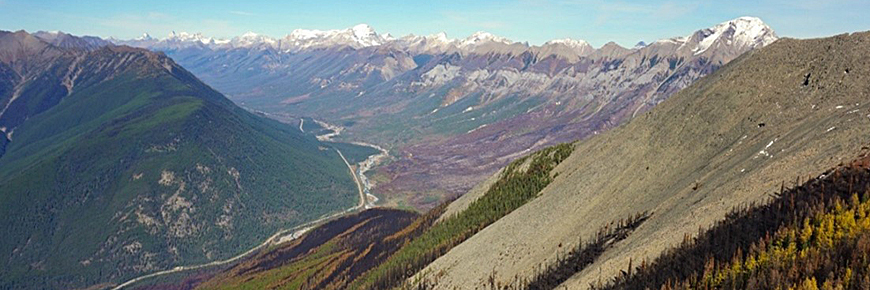
State of the Park Assessment 2018: Executive Summary
Kootenay National Park
Each national park requires a management plan that describes its vision and broad direction. The management planning process takes place every 10 years and involves: assessing the current state of park resources; determining key trends, pressures and opportunities; setting priorities; and seeking input from all Canadians. A standardized approach allows Parks Canada to compare parks and sites across the Parks Canada network.
Because national parks change over time in response to many factors, a state of the park assessment is the first step in the management planning process. It provides a ‘report card’ on the condition of natural and cultural resources and aspects of Parks Canada’s work in a national park and describes whether the condition shows an improving, declining or stable trend. Condition ratings are determined through on-going monitoring, surveys and other forms of feedback, gathered since the previous Kootenay National Park Management Plan was approved in 2010.
Key indicators are grouped into six main themes: ecological integrity, cultural resources, external relations, Indigenous relations, visitor experience and built assets. Indicators are rated as: Good, Fair, or Poor
The State of the Park Assessment (SOPA) uses data from a variety of sources, such as ecological monitoring results, visitor surveys, attendance counts, and built asset inspections. Based on a review of key indicators, the following are the results for Kootenay National Park:
Ecological integrity
Parks Canada protects natural places. When our places have ecological integrity, we’re succeeding. We evaluated a variety of measures for three important ecosystems in Kootenay National Park to rate their overall condition.
The Forest Ecosystem Good
Monitoring shows forest birds and mammals are doing well. Recent wildfires and prescribed burns have helped to create diverse forest habitat. More work is needed to restore fire in key areas. Non-native plants found near disturbed areas like roadways and park facilities are competing with species normally found in the park.
The Alpine Tundra Ecosystem Good
Birds, small mammals, and native plant populations are all in good condition. Mountain goat populations and the amount of available alpine habitat will be monitored and rated in the next SOPA.
The Aquatic Ecosystem Poor
Frog, toad and salamander populations and water quality are in good condition. However, the overall rating is poor. This is due to the presence of non-native fish and old culverts in roadways that block fish movement. These problems reflect historic stocking of non-native fish and former road building techniques that failed to keep aquatic habitat connected.
Cultural resources Fair
Archaeological sites are in fair condition. Restoration work on built heritage sites is underway at the Radium Hot Springs Aquacourt will improve the condition of this heritage building. Other heritage buildings in the park require additional review by experts before they can be rated. The condition of archaeological objects within Parks Canada’s collection is rated as fair because of corrosion or deterioration that occurred before they were collected. None of these objects are at risk of further deterioration.
External relations Good
Outreach is rated as good. Parks Canada staff brought Kootenay’s stories to Canadians at a variety of events and venues in Calgary, Vancouver and Toronto. The number of contacts at these events has increased 40% since 2016. Support for the park, as measured by volunteer hours, is also rated as good. The number of hours volunteers gave to park projects increased significantly from 2016.
Visitor experience Good
The number of park visitors has risen by 24% since 2011. In a 2011 survey, visitors rated enjoyment and overall satisfaction as good. They were less-satisfied with pre-trip planning information and the value for their entry fees. Online trip-planning content has been improved since 2011.
Indigenous relations
Kootenay National Park forms part of the traditional territory of the Ktunaxa and Secwepemc peoples. Parks Canada is developing working relationships with the Secwepemc Nation and the Ktunaxa National Council which represents the Akisq’nuk, Aq’am, Tobacco Plains and Lower Kootenay community bands. These relationships are in a formative stage. Indigenous relations indicators are not yet rated.
Built assets Fair
Built assets are rated as fair for Kootenay National Park, however highways are rated poor. Significant work is underway to improve park assets. In particular, extensive highway work is nearing completion. When completed, the condition ratings for these assets are expected to improve.
Key Issues Identified for Consideration in the Park Management Plan Review
The SOPA identifies key areas that require attention during the park management plan review:
Aquatic Ecosystem Restoration:
The condition of aquatic ecosystems is poor. The historical stocking of non-native fish in rivers and lakes continue to have a significant effect on aquatic ecosystems. Old culverts in roadways that block fish movement also remain a problem. Improving aquatic ecosystems will require more time and effort as initiatives like replacing culverts during highway twinning require a great deal of time
and resources to complete.
Forest Ecosystem Restoration:
Forests are in fair condition. Wildfire suppression in the 20th century has changed forest ecosystems. Recent wildfires and prescribed burns conducted in the last decade have begun to
address this issue, but additional work to restore fire is still required in several key areas. Protecting whitebark pine and controlling non-native vegetation will also improve forest ecosystem health.
Indigenous Relationships:
Indigenous people are not involved significantly in the park. Parks Canada is working to advance reconciliation and develop relationships with Indigenous groups with traditional ties to Kootenay National Park.
Built Asset Sustainability:
The park built assets are in fair condition. Continued investment is required to improve their condition.
Cultural Resource Inventory:
There is limited information on the condition of heritage buildings and objects in Kootenay National Park. Additional evaluation is needed to support the restoration and maintenance of heritage character.
Related links
- Date modified :